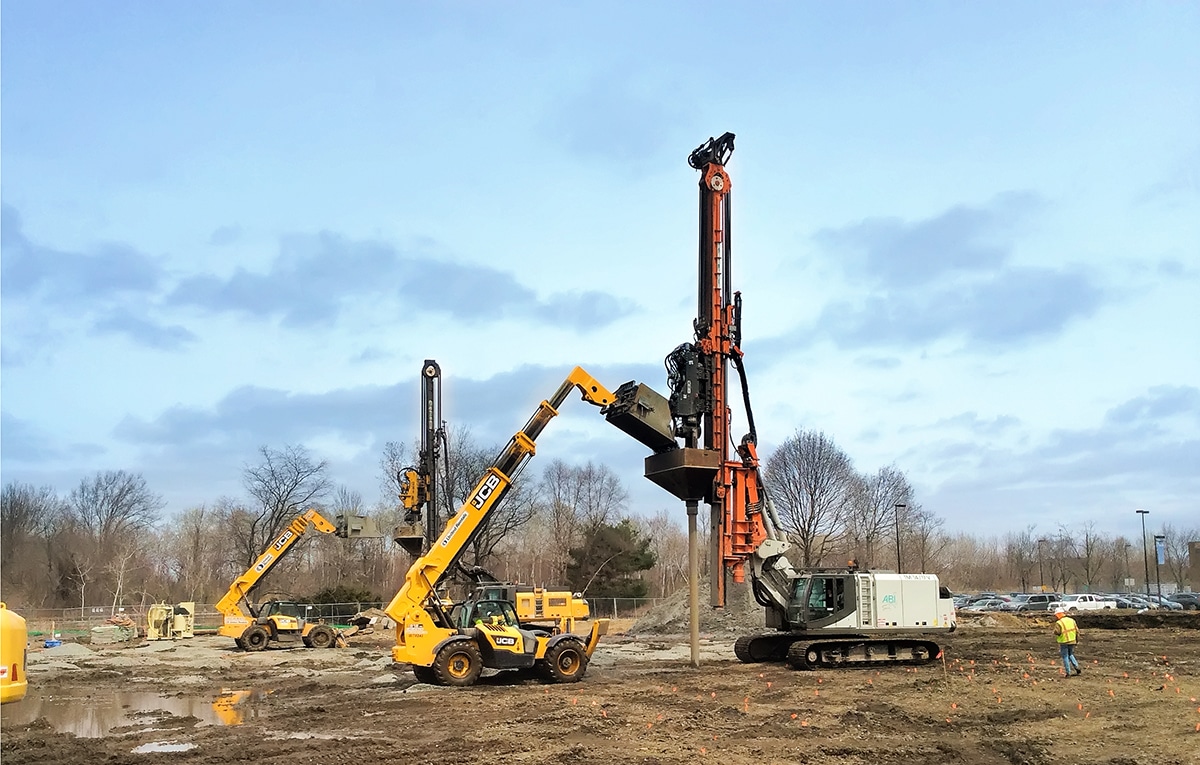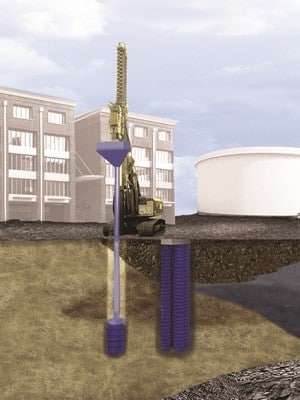Geopier Impact® Rammed Aggregate Piers (RAPs) are a versatile ground improvement solution designed to reinforce poor soils through the use of a patented displacement mandrel. This displacement construction method can be used in a variety of soil conditions.
- Soils below the groundwater table
- Caving soils
- Loose sands
- Soft silts and clays
- Organic soils (peat, organic silt)
- Mixed soil layers
- Uncontrolled fill
- Contaminated soils
Geopier Impact Rammed Aggregate Piers Can Address a Number of Ground Construction Challenges
- Reinforce unsuitable soil conditions
- Increase soil bearing capacity
- Footing settlement control
- Slab settlement control
- Soil liquefaction mitigation
Construction Process
- The mandrel is vibrated into the ground to the desired RAP depth using high-frequency, low amplitude energy.
- The mandrel and hopper are then filled with a sufficient amount of stone to construct the RAP.
- The mandrel is raised to a preset distance while discharging the stone into the cavity created by the displacement mandrel.
- The mandrel is then rammed downward/vertically to a preset distance to create a compacted lift.
- Steps 3 and 4 are repeated until the RAP is built to the ground surface. Subsequent footing excavation removes the upper “sacrificial” portion of the RAP.
A Closer Look at Geopier Impact Rammed Aggregate Pier Technology
Impact RAPs are the most widely used Geopier Ground Improvement system in the Northeast. These ground improvement elements reinforce unsuitable soils to provide an improved subgrade for traditional shallow footings and slab-on-grade support. Impact RAP diameters range from approximately 20 to 24 inches and larger diameters are possible for the right applications.
Impact RAPs consist of stiff columns of rammed aggregate that are constructed with a patented displacement mandrel equipped with a beveled tamping foot. The mandrel and tamping foot apply direct vertical ramming energy to densely compact successive lifts of high quality crushed rock. The vertical ramming action also increases the lateral stress and improves the surrounding soils, resulting in high-stiffness engineered elements.
Geopier Impact RAPs can also be grouted to provide enhanced stiffness through relatively soft layers (such as organics or soft clay). During installation, cement grout is introduced into the hollow mandrel and filled to a prescribed depth. Aggregate is then placed into the mandrel and the combination grout/aggregate is used in the RAP element construction. The grout binds the compacted aggregate together, strengthening the RAP through the soft soil layers.
Key Advantages
- Replaces more expensive deep foundations such as piles or pressure injected footings (PIFs).
- Vertical impact ramming results in a high-stiffness element and an improved surrounding soil matrix.
- Grout can be added to improve stiffness in soft soil layer such as clay or organics.
- Dewatering is not required.
- No spoils are generated during the displacement process.
- Does not require casing.
- Treatment depths can exceed 40 feet.
- Rapid installation process allows for shorter schedules.
- Versatile system that can address a variety of soil and groundwater conditions.
- Proven system that has been installed in more than 350 projects throughout the Northeast.
- Designed, built and managed with local engineering, manpower and equipment.
Recent Geopier Impact RAP Projects
- Assembly Row – Somerville, MA
- One North of Boston – Chelsea, MA
- Lowell Charter School – Lowell, MA
- Aldi Retail – Nashua, NH
- Future Generation Wind Turbine – Buzzards Bay, MA
- State Street Residential – New Haven, CT
- Burlington Skate Park – Burlington, VT
- Cumberland Farms – Latham, NY




